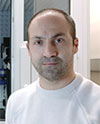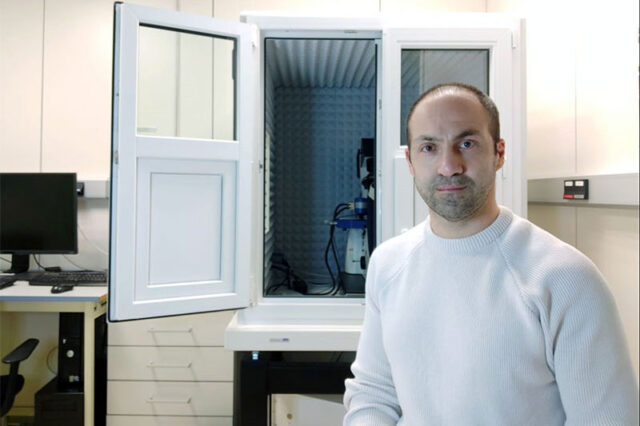Name: Adai Colom
Current position: Group leader
Place: Biofisika Institute (Spain)
Research topic: Cell membrane organization and dynamics
What was your position and research topic with the NCCR Chemical Biology?
I was a postdoc in Aurélien Roux’s lab (UNIGE), where we developed new methods for the study of cell membrane mechanics in cellulo and in vitro together with the group of Stefan Matile, who created the Flipper-TR® molecule, a probe mechanosensitive to membrane lipid composition.
What was your experience in the Roux lab?
In one word: Fantastic! I came to the lab with the objective to learn different techniques and ways to focus on different biological problems and I left with that knowledge and much more. People in my team were more than great; I learned a lot from each one of them and it was always a pleasure to go to the lab.
What helped you to open your own lab? And what were the main hurdles you had to overcome to be where you are now?
What really helped me is the support I received from colleagues and from the Biofisika Institute. The rules and project management framework are different here from Switzerland and my institute had to guide me especially during the CoV2 pandemic. I learned how important it is to ask feedback from more experienced colleagues. The Institute helped me to set up the lab and granted in my team an incredible technician who knows well the place. As the main hurdle I had to face, I would mention the lack of time. I started my lab during a very weird moment, with almost everything closed, so I could not get the material and the feedback that I would have normally.
What is your current research topic?
Cell membrane mechanics, specifically during immunological synapse and viral infection.
What was the best or most exciting moment of your career?
I had several exciting moments during both my PhD and postdoc. The most recent one is when I got my first grant (MINECO) as a PI! In Spain, there are not many funding opportunities and receiving this grant is not only a great help to start the lab, but also a form of recognition as an independent researcher. The Institute of Biofisika helped me a lot to obtain the MINECO grant, but also, before that to obtain the Ramon y Cajal grant from the Spanish State Research Agency.
What did you find unique about your collaboration with the NCCR Chemical Biology?
The opportunity to collaborate with many people that have very different backgrounds. It proved me how nice it is to focus on a problem from different perspectives.
What are the skills you acquired with the NCCR?
We had many courses and retreats organized by the NCCR, like courses on soft skills and a Symposium on Careers in Science, which I found very interesting and useful. Still, the most significant “skill” I learned then is the importance of having an interdisciplinary focus on a project.
What advice would you give to a junior scientist interested in pursuing your path?
The most important one: enjoy what you are doing in the lab. Also, learn from the people you have around you and ask as many questions as you need to your colleagues, because sometimes a good collaboration can evolve from these questions.
 Adai Colom is a group leader at the Biofisika Institute in Leioa (Spain). He did his PhD between the Institute Curie in Paris and Aix-Marseille University (France), under the supervision of Prof. Simon Scheuring, and succeeded to develop one of the first High-Speed Atomic Force Microscopes (HS-AFM) with an optical setup, which provided the first molecular movies of membrane proteins in living cells. Then, in 2014, Adai did a postdoc with Prof. Aurélien Roux at the University of Geneva where he developed new methods to study cell trafficking and membrane mechanics in cells and in vitro in collaboration with other labs from the NCCR Chemical Biology. Since 2020, he has joined the Biofisika Institute (Spain) as a PI researcher. He has been received as an Ikerbasque and Ramon y Cajal Fellow. Adai will be presenting his work as an emerging investigator at the International Symposium on Chemical Biology 2022.
Adai Colom is a group leader at the Biofisika Institute in Leioa (Spain). He did his PhD between the Institute Curie in Paris and Aix-Marseille University (France), under the supervision of Prof. Simon Scheuring, and succeeded to develop one of the first High-Speed Atomic Force Microscopes (HS-AFM) with an optical setup, which provided the first molecular movies of membrane proteins in living cells. Then, in 2014, Adai did a postdoc with Prof. Aurélien Roux at the University of Geneva where he developed new methods to study cell trafficking and membrane mechanics in cells and in vitro in collaboration with other labs from the NCCR Chemical Biology. Since 2020, he has joined the Biofisika Institute (Spain) as a PI researcher. He has been received as an Ikerbasque and Ramon y Cajal Fellow. Adai will be presenting his work as an emerging investigator at the International Symposium on Chemical Biology 2022.


Leave a comment
The editors reserve the right not to publish comments or to abridge them.